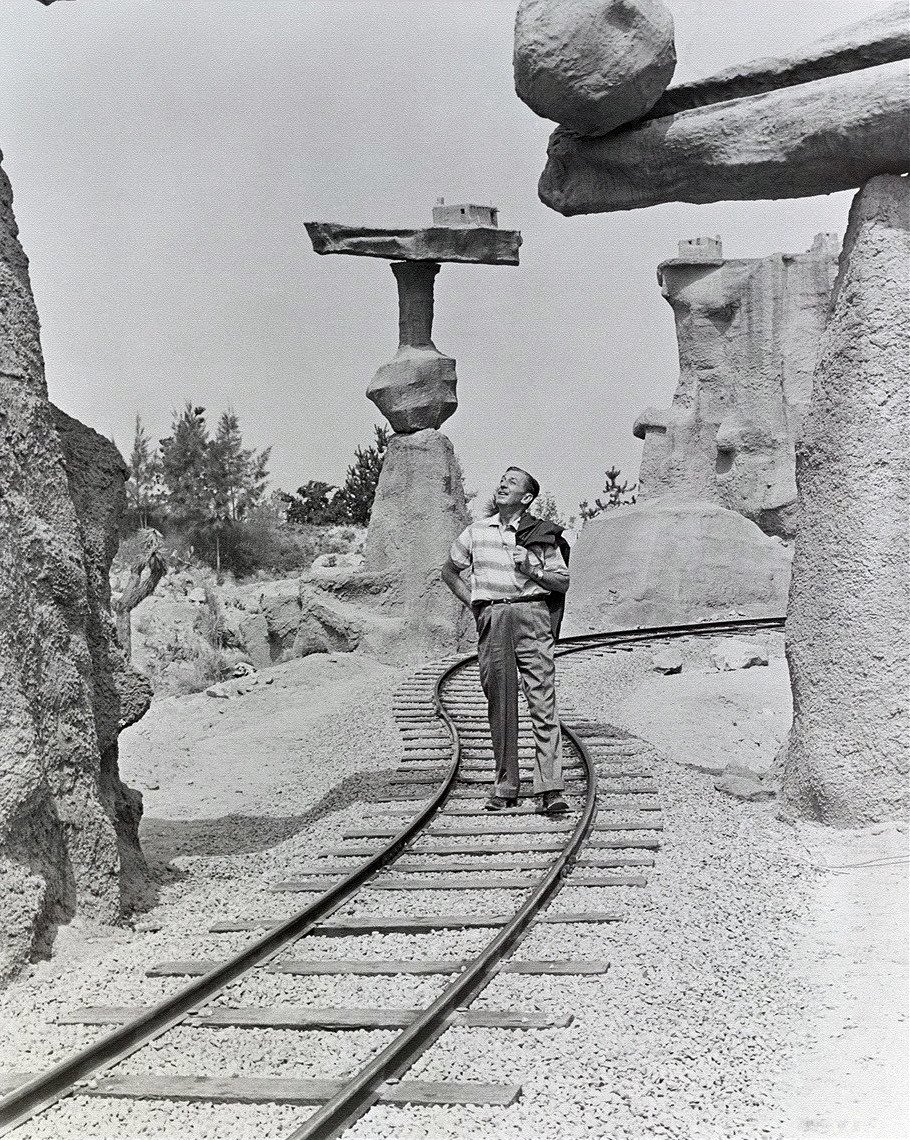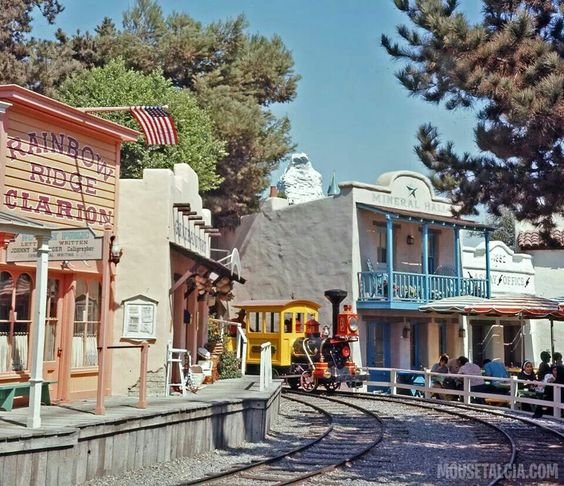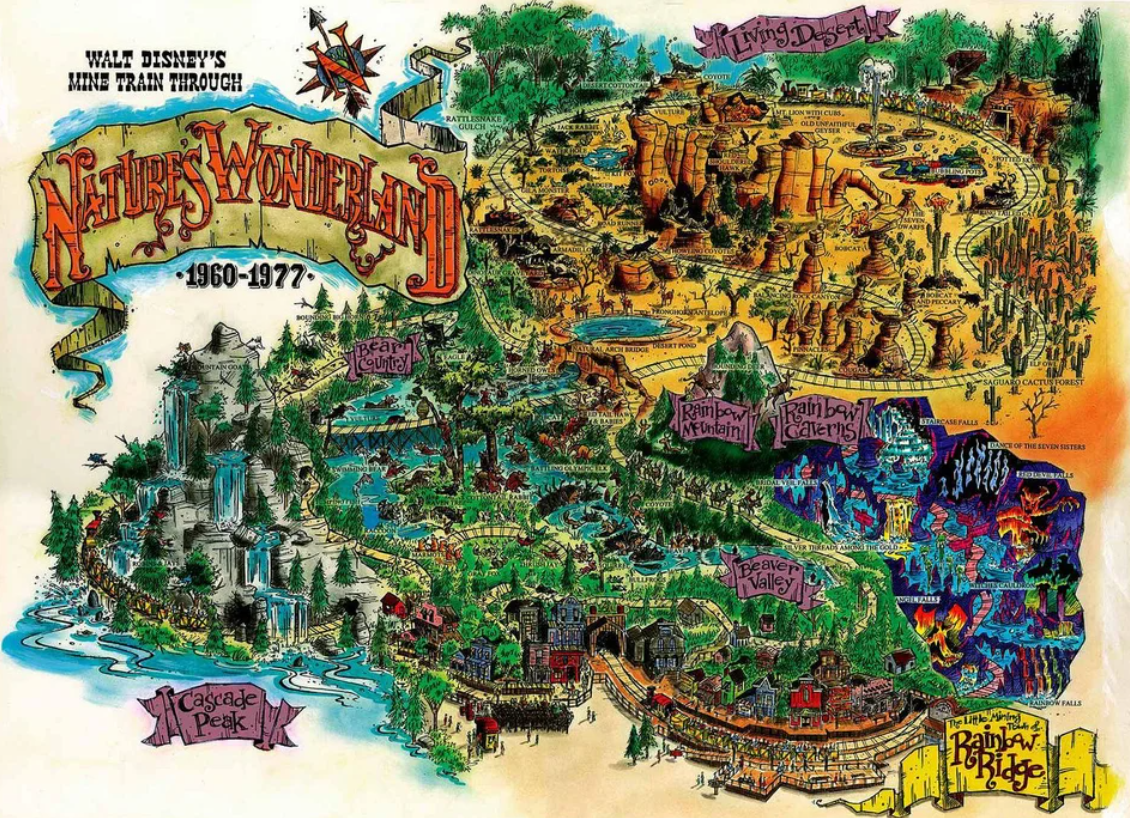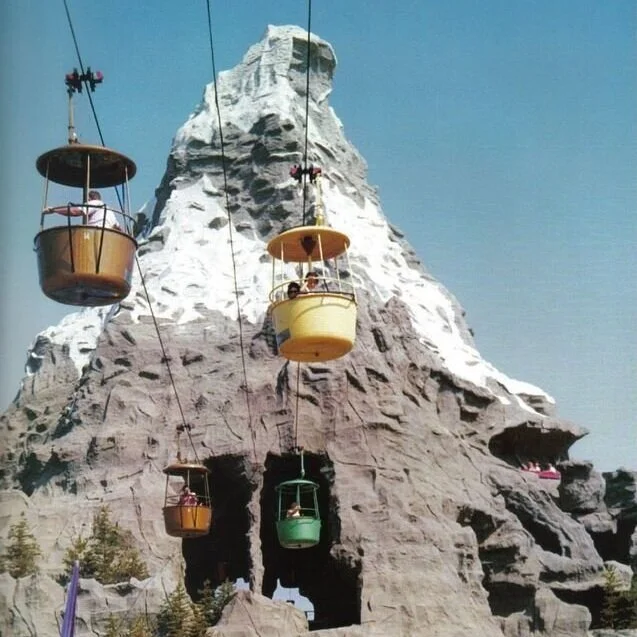From Rainbow Caverns Mine Train & Mine Train Through Nature's Wonderland, to Big Thunder Mountain Railroad
“Hang onto your hats and glasses, folks, cause this here’s the wildest ride in the wilderness!”
Big Thunder Mountain is one of the most beloved Disney attractions throughout all of the Disney parks. This Frontierland staple was not always the wildest ride in the wilderness though, and not even the wildest ride in the entire park. It actually began as a bit of a tame ride, a train ride to take you all across the North American deserts to witness nature at work. This version of our infamous Western ride was called Rainbow Caverns Mine Train, the first iteration of this attraction.
Big Thunder Mountain Railroad. Image from: https://insidethemagic.net/2021/08/big-thunder-mountain-refurbishment-th1/
Opening Day Frontierland (1955)
Frontierland today is filled with opportunities to take an adventure to the Old West, including on the 18-century Sailing Ship Columbia, the Pirate’s Layer on Tom Sawyer Island, and aboard the Mark Twain Riverboat. Back when the park first opened, the land had a much different purpose. It would serve as a genuine western desert, often referred to as the Living Desert named after the 1953 Disney True-Life Adventure film, where you could find stagecoaches, Yellowstone coaches, surreys, and ride Conestoga wagons. Cowboys, horses, saloons, you name it were a part of the original Frontierland, just as Walt envisioned it. Of course with time, the novelty of these time periods wore off, and Imagineers knew they had to add an eye-catching attraction to keep guests interested in the land. Thus, the idea of Rainbow Caverns Mine Train was born.
Vintage Frontierland. Image from: https://www.destinationtips.com/destinations/disneyland-then-and-now/14/
Rainbow Caverns Mine Train (1956)
There were several Disneyland attractions added in 1956 after the first year of the park being open. 3 of them were dedicated to Frontierland: Pirate’s Layer on Tom Sawyer Island, Davy Crockett’s Explorer Canoes, and Rainbow Caverns Mine Train. The mine train would open on July 2, 1956, covering an incredible 7 acres of Disneyland. The ride would follow a Jungle Cruise-esque format, carrying guests through the Rainbow Ridge mining town and through Rainbow Desert, where they could see wildlife and desert nature in a way never done before. The stagecoaches and wagons continued to be a part of Frontierland even after this expansion, but took different routes to not interfere with the railroad.
The Locomotives for Rainbow Caverns Mine Train
Walt acquired the help of Roger Broggie, who famously helped Walt build his beloved backyard locomotive, the Lilly Belle. Roger also was responsible for bringing the railroad to Walt Disney World, as per Walt’s wishes before he died. For the Mine Train, Roger designed the locomotives after early 1900s trains, with wood and brass being the main elements. There were 4 trains, each with 6 cars, equipped with speakers for the train engineers to guide the tour through the desert, just like on the Jungle Cruise.
A Ride on Rainbow Caverns Mine Train
The ride whisked you away from the Rainbow Ridge town, took you around the cactuses and Joshua trees along the land, across a stone bridge, around Rainbow Mountain, between balancing rocks, and becoming surrounded by Devil’s Paint Pots. These miniature volcanoes spewed colourful lava for guests to enjoy. The final part of the ride was the main spectacle, the rainbow caverns. These caverns were filled with colourful waterfalls, Mysteriously (and understandably), there are no coloured photos or videos of the rainbow caverns to date.
Rainbow Caverns Mine Train poster. Image from: https://vegalleries.com/art/disneyana/4282/disneyland-theme-parks/rainbow-caverns-attraction-poster-id-jandisneyland19900
Walt Disney on the tracks of the Rainbow Caverns Mine Train. Image from: https://adventurelandia.tumblr.com/post/670227790824652800/walt-disney-walking-on-the-tracks-of-the-rainbow
Mine Train Through Nature’s Wonderland (1960)
Though the attraction did bring more attention to Frontierland, it could still be improved. The Rainbow Caverns Mine Train closed for refurbishment on October 11, 1959, and reopened again on June 12, 1960 as Mine Train Through Nature’s Wonderland. It would be an expansion of the original ride with even more exciting elements for guests to enjoy. It would still follow the Jungle Cruise format, just with more wildlife to see. There were over 150 plant life types added and over 200 audio-animatronic animals added. It was a massive project that costed almost 4.5 times the amount that the original Rainbow Caverns Mine Train did. Just like how The Living Desert was incorporated into the ride, other True-Life Adventure titles were also featured, including Beaver Valley, the Olympic Elk, and Bear Country. This gave the designers a guide to follow when deciding what animals and wildlife were to be created for this new adventure.
Rainbow Ridge for Mine Train Through Nature’s Wonderland. Image from: http://www.matterhorn1959.com/blog/natureswonderland3.jpg
Pack Mules and Cascade Peak
By 1960, the stagecoaches and wagons had been phased out of Frontierland, but the mule ride stayed, now dubbed the Pack Mules Through Nature’s Wonderland. Cascade Peak, a 75-foot tall mountain with raging waterfalls was added as a part of the attraction. Cascade Peak would survive well past Mine Train Through Nature’s Wonderland, standing for another 19 years thereafter.
Cascade Peak. Image from: https://vintagedisneyparks.tumblr.com/page/447
Rainbow Ridge, Beaver Valley, and Bear Country
The mining town of Rainbow Ridge gained a few new storefronts to make the beginning of the ride just as entertaining as all other parts of it, and really pull you into the Old West theme of the attraction. The train would take you through a tunnel and into Beaver Valley, where you could witness beavers at work chomping their wood, squirrels, raccoons, rabbits, foxes and other forest animals.
“As we come out of this first tunnel, we’ll be entering Beaver Valley. Them little marmots over the tunnel must be whistlin’ to all you pretty gals.”
The next sight to see after Beaver Valley was going across a bridge by Cascade Peak, where you could feel the mist coming from the waterfall on your skin. Here you could see jumping fish, mountain goats, and swimming bears beneath you. This would take you into Bear Country, where you could gaze over Bear Creek and see 2 large elk with intertwined antlers, fighting each other. Moving away from the waters and back into the desert land, you passed through the natural arch bridge, and into the area that was most similar to the original ride. Cacti, rocks, bobcats, cougars, coyotes and vultures occupied this area. The Devil’s Paint Pots remained here, still exploding with bright colours.
“We’re comin’ into Bear Country now, folks. And while we’re crossing the old trestle, you gotta sit real still. No tellin’ how long she’s gonna last. You know bears are one of the most playful animals there is. Lazy too. All they wanna do is lay around ‘n scratch, n’ fish, n’ swim, that is when they ain’t sleepin’. ”
The Natural Arch Bridge. Image from: https://www.davelandweb.com/nw/images/50s/PBTStars_11_58_N26R.jpg
The Devil Paint Pots. Image from: https://www.davelandweb.com/nw/images/KTPBK_5_58_N04R.jpg
The Living Desert and Rainbow Caverns
The train would take you in a circular shape around the Living Desert, with the other half being a forest filled with desert cottontails, rattlesnakes, waterholes, tortoises, badgers, and armadillos. While exiting the forest, you were faced with the balancing rocks again, which would spin and wobble side to side.
The final part of the ride kept its original charm with the Rainbow Caverns, originally designed by genius Claude Coats and remained majorly unchanged. It was the most popular and most loved part of the ride, and contributed to the reason why the Mine Train stayed open for 17 years. It officially closed on January 2, 1977, to make room for a more thrilling ride.
“Now, we’re goin’ deep into the earth to view the dazzling Rainbow Caverns. You’ll see giant stalagmites, stalactites, ‘n colorful falls on ever’ side. Say, if ya look real careful, you’ll see geyser grotto, ‘n even the witch’s cauldron.”
Mine Train Through Nature’s Wonderland map. Image from: https://preview.redd.it/6z33vfcvg9w71.jpg?width=960&crop=smart&auto=webp&s=33a8f721ccabd1b6eead72c9093122e8cdfaed5d
Big Thunder Mountain Railroad (1979)
In the early 1970s, beloved Disney Imagineer Tony Baxter began the design work for an all-new thrill ride to grace the scene at Frontierland and replace the Mine Trains: Big Thunder Mountain Railroad. He took inspiration from Marc Davis’s work on Western River Expedition, a ride that didn’t come to fruition at the Magic Kingdom due to costs and the opening of Pirates of the Caribbean. However, in 1974, the project was shelved to make time for the construction of Space Mountain in 1977. These 2 rides acted as ways for Disneyland to appeal to their new audience who were looking for more modern thrill rides. Big Thunder Mountain was picked back up in the late 1970s and officially opened on September 2, 1979.
Big Thunder Mountain Railroad. Image from: https://geektyrant.com/news/the-guy-behind-the-voice-on-disneylands-big-thunder-mountain-looks-exactly-like-you-imagined
As to not waste all of the incredible work that had been done on the Mine Train decades prior, they did incorporate a lot of that work into Big Thunder, some things that you can still see today.
Remnants of Mine Train Through Nature’s Wonderland Today
One of the coolest parts that has been preserved is the entrance tunnel to Cascade Peak, which can be seen from a walkway close to Big Thunder. This tunnel is where the train bridge used to be, though the bridge has been removed. From that same walkway, if you look below, you can still see some of the jumping fish animatronics every once in a while. Another animatronic that was taken from the original ride was a panther, who now lives in Adventureland along the track of the Disneyland Railroad.
One of the most pictured parts of Big Thunder Mountain is the giant dinosaur bones that hover over the track near the bottom of the ride. These dinosaur bones first lived in Rainbow Desert.
Along the loading dock of the ride and when standing in the queue, you can still see all of the storefronts that once were a part of the Rainbow Ridge Mining Town.
Just outside of Big Thunder Mountain, you can also spot a boarded up tunnel, which used to take guests just to the surface of Cascade Peak. This boarded up tunnel still has pieces of the original track below.
One remnant that did stand for a long time in Disneyland but has since been removed, was one of the original locomotives from Mine Train Through Nature’s Wonderland along one of the forest-y banks of the Rivers of America. The railroad track still sits there, and that bank would have been where Cascade Peak did stand for so many years.
Though Big Thunder Ranch closed in 2016 to make room for Star Wars: Galaxy’s Edge, some of the balancing rock formations lived in the ranch until its closure. The old Pack Mule trail and gate is still over in that area though, just to the left of the exit through Frontierland into Galaxy’s Edge.
Some elements of the Mine Train ride were moved into Florida for Walt Disney World’s version of Big Thunder, including some of the cacti, bobcats, peccaries, and mountain sheep.
Reference list:
https://en.wikipedia.org/wiki/Mine_Train_Through_Nature%27s_Wonderland
https://d23.com/a-to-z/rainbow-caverns-mine-train/
https://www.youtube.com/watch?v=oHIiHwopeVg
https://www.youtube.com/watch?v=QoqhzzuIhI8
https://www.yesterland.com/rcminetrain.html
https://www.yesterland.com/minetrain.html
https://www.yesterland.com/cascadepeak.html
Janzen, Jack E., Janzen, Leon J. The "E" Ticket #29 The Disneyland Mine Train. Vol. 29, 1998.














